Black Pepper...worth its weight in gold!
By Louis S. Luzzo, Sr.
 So common is black pepper today that generally, we take it for granted. Not so in ancient times and history will show that at one time, with its value in weight rivaling that of gold, many pepper barons made their fortunes from this unique little berry. Looking back, pepper was considered one of the five essential luxuries upon which foreign trade with the Roman empire was based, the others being African ivory, Chinese silk, German amber, and Arabian incense.
So common is black pepper today that generally, we take it for granted. Not so in ancient times and history will show that at one time, with its value in weight rivaling that of gold, many pepper barons made their fortunes from this unique little berry. Looking back, pepper was considered one of the five essential luxuries upon which foreign trade with the Roman empire was based, the others being African ivory, Chinese silk, German amber, and Arabian incense.
Black pepper is native to South India and is extensively cultivated there and elsewhere in tropical regions. J. Innes Miller notes that while pepper was grown in southern Thailand and in Malaysia, its most important source was India, particularly the Malabar Coast, in what is now the state of Kerala. The Coast, also known as the Malabarian Coast, is a long and narrow south-western shore line of the mainland Indian subcontinent. Geographically, the Malabar Coast, especially on its westward-facing mountain slopes,  comprises the wettest region of southern India, as the Western Ghats intercept the moisture-laden monsoon rains, especially on their westward-facing mountain slopes. The term "Malabar Coast" is also sometimes used in reference to the entire Indian coast from the western coast of Konkan to the tip of the subcontinent at Cape Comorin. It is flanked by the Arabian Sea on the west and the Western Ghats on the east. The Southern part of this narrow coast is the South Western Ghats moist deciduous forests.
comprises the wettest region of southern India, as the Western Ghats intercept the moisture-laden monsoon rains, especially on their westward-facing mountain slopes. The term "Malabar Coast" is also sometimes used in reference to the entire Indian coast from the western coast of Konkan to the tip of the subcontinent at Cape Comorin. It is flanked by the Arabian Sea on the west and the Western Ghats on the east. The Southern part of this narrow coast is the South Western Ghats moist deciduous forests.
The term "peppercorn rent" is often used to denote a pittance, but in medieval times, a pound of pepper was the equivalent of a pound of gold or up to three weeks labor for trade purposes. Peppercorns are not only the oldest used spice, but also the most widely-used. Said to be found more than 4,000 years ago, peppercorns have possibly been cultivated as far back as 2000 B.C.
 The pepper plant itself is a perennial vine that has dark green leaves and small white flowers. These flowers become clusters of green berries, which is the product known as green peppercorns. Black peppercorns are the unripe berries that have been sun-dried, while white peppercorns are just black peppercorns with their outer skins rubbed off.
The pepper plant itself is a perennial vine that has dark green leaves and small white flowers. These flowers become clusters of green berries, which is the product known as green peppercorns. Black peppercorns are the unripe berries that have been sun-dried, while white peppercorns are just black peppercorns with their outer skins rubbed off.
Today, pepper, known as the King of Spices and the Master Spice, still accounts for one-fourth of the world's spice trade. Tunisians lead in pepper consumption with half a pound per person per year, whereas Americans consume about one-quarter pound per year.
Although always prized as a flavor-enhancing spice, the peppercorn first gained fame for medicinal purposes as a digestive stimulant and expectorant. Its hot and pungent flavor causes the membranes inside the nose and throat to exude a lubricating secretion, helpful to those in respiratory distress as an aid to cough up offending phlegm and mucus. Pepper was also used in an external ointment to relieve skin afflictions and hives.
Believe it or not, it is also an effective deterrent to insects. A solution of one-half teaspoon freshly ground pepper to one quart of warm water sprayed on plants can be toxic to ants, potato bugs, silverfish, and even roaches and moths. A sprinkling of ground pepper will also deter insect paths in non-garden areas.
Pepper gets its spicy heat mostly from the piperine compound, which is found both in the outer fruit and in the seed. Refined piperine, milligram-for-milligram, is about one percent as hot as the capsaicin in chilli peppers. The outer fruit layer, left on black pepper, also contains important odor-contributing terpenes which give citrusy, woody, and floral notes. These scents are mostly missing in white pepper, which is stripped of the fruit layer. White pepper can gain some different odors 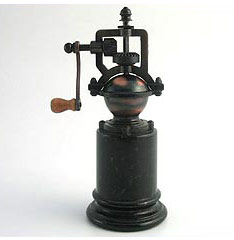 (including musty notes) from its longer fermentation stage.
(including musty notes) from its longer fermentation stage.
History
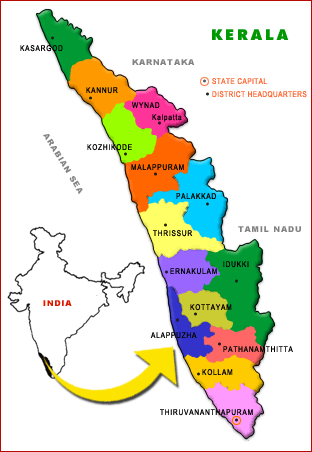 Pepper has been used as a spice in India since prehistoric times. It is native to India and has been known to Indian cooking since at least 2000 BC. Peppercorns were a much prized trade good, often referred to as "black gold" and used as a form of commodity money. The term "peppercorn rent" is often used to denote a pittance, but in medieval times, a pound of pepper was the equivalent of a pound of gold or up to three weeks' labor for trade purposes.
Pepper has been used as a spice in India since prehistoric times. It is native to India and has been known to Indian cooking since at least 2000 BC. Peppercorns were a much prized trade good, often referred to as "black gold" and used as a form of commodity money. The term "peppercorn rent" is often used to denote a pittance, but in medieval times, a pound of pepper was the equivalent of a pound of gold or up to three weeks' labor for trade purposes.
Until well after the Middle Ages, virtually all of the black pepper found in Europe, the Middle East, and North Africa traveled there from India's Malabar region via the Silk Road routes. By the 16th century, pepper was also being grown in Java, Sunda, Sumatra, Madagascar, Malaysia, and elsewhere in Southeast Asia, but these areas traded mainly with China, or used the pepper locally. Ports in the Malabar area also served as a stop-off point for much of the trade in other spices from farther east in the Indian Ocean.
Black pepper, along with other spices from India and lands farther east, changed the course of world history. It was in some part the preciousness of these spices that led to the European efforts to find a sea route to India and consequently to the European colonial occupation of that country, as well as the European discovery and colonization of the Americas.
 Black peppercorns were found stuffed in the nostrils of Ramesses II, placed there as part of the mummification rituals shortly after his death in 1213 BC. Little else is known about the use of pepper in ancient Egypt, nor how it reached the Nile from India. Pepper (both long and black) was known in Greece at least as early as the 4th century BC, though it was probably an uncommon and expensive item that only the very rich could afford.
Black peppercorns were found stuffed in the nostrils of Ramesses II, placed there as part of the mummification rituals shortly after his death in 1213 BC. Little else is known about the use of pepper in ancient Egypt, nor how it reached the Nile from India. Pepper (both long and black) was known in Greece at least as early as the 4th century BC, though it was probably an uncommon and expensive item that only the very rich could afford.
With ships sailing directly to the Malabar coast, black pepper was now traveling a shorter trade route than long pepper, and the prices reflected it. Pliny the Elder's (I love this guy)Natural History tells us the prices in Rome around 77 AD: "Long pepper ... is fifteen denarii per pound, while that of white pepper is seven, and of black, four."
Black pepper was a well-known and widespread, if expensive, seasoning in the Roman Empire. Apicius' De re coquinaria, a 3rd-century cookbook probably based at least partly on one from the 1st century AD , includes pepper in a majority of its recipes. Edward Gibbon wrote, in The History of the Decline and Fall of the Roman Empire, that pepper was "a favorite ingredient of the most expensive Roman cookery".
Pepper was so valuable that it was often used as collateral or even currency. In the Dutch language, "pepper expensive" (peperduur) is an expression for something very expensive. The taste for pepper (or the appreciation of its monetary value) was passed on to those who would see Rome fall. It is said that Alaric the Visigoth and Attila the Hun each demanded from Rome a ransom of more than a ton of pepper when they besieged the city in 5th century. After the fall of Rome, others took over the middle legs of the spice trade, first the Persians and then the Arabs; Innes Miller cites the account of Cosmas Indicopleustes, who traveled east to India, as proof that "pepper was still being exported from India in the sixth century". By the end of the Dark Ages, the central portions of the spice trade were firmly under Islamic control. Once into the Mediterranean, the trade was largely monopolized by Italian powers, especially Venice and Genoa. The rise of these city-states was funded in large part by the spice trade.
Its exorbitant price during the Middle Ages—and the monopoly on the trade held by Italy—was one of the inducements which led the Portuguese to seek a sea route to India. In 1498, Vasco da Gama became the first person to reach India by sailing around Africa; Though this first trip to India by way of the southern tip of Africa was only a modest success, the Portuguese quickly returned in greater numbers and used their superior naval firepower to eventually gain complete control of trade on the Arabian sea. It was given additional legitimacy (at least from a European perspective) by the 1494 Treaty of Tordesillas, which granted Portugal exclusive rights to the half of the world where black pepper originated.
The Portuguese proved unable to maintain their stranglehold on the spice trade for long. The old Arab and Venetian trade networks successfully smuggled enormous quantities of spices through the patchy Portuguese blockade, and pepper once again flowed through Alexandria and Italy, as well as around Africa. In the 17th century, the Portuguese lost almost all of their valuable Indian Ocean possessions to the Dutch and the English. The pepper ports of Malabar fell to the Dutch in the period 1661–1663.
Cultivation & Harvesting
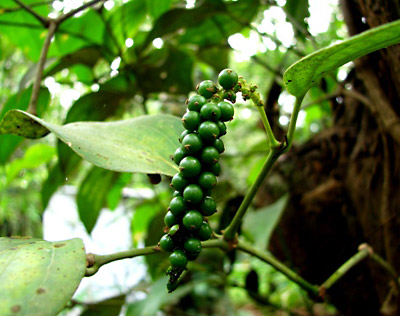 The pepper plant is a perennial woody vine growing to four meters in height on supporting trees, poles, or trellises. It is a spreading vine, rooting readily where trailing stems touch the ground. Peppercorns are the seed berries of the Piper nigrum (piper being Latin for plant, and nigrum meaning black) vine, originating on the Malabar coast of India.
The pepper plant is a perennial woody vine growing to four meters in height on supporting trees, poles, or trellises. It is a spreading vine, rooting readily where trailing stems touch the ground. Peppercorns are the seed berries of the Piper nigrum (piper being Latin for plant, and nigrum meaning black) vine, originating on the Malabar coast of India.
They are left on mats to dry and ferment in the sun and this must be done quickly to prevent mold. Because the pungency of black peppercorns comes mostly from the outer, black cover, they are stronger than the white peppercorns.
 In ancient days, the typical pepper orchard in India consisted of a small plot of land where moisture and shade were abundant. The pepper vines would be planted next to tall trees in order to be able to train the vine's growth pattern. The idea was to get the plant to grow upwards, allowing full berry production.
In ancient days, the typical pepper orchard in India consisted of a small plot of land where moisture and shade were abundant. The pepper vines would be planted next to tall trees in order to be able to train the vine's growth pattern. The idea was to get the plant to grow upwards, allowing full berry production.
Pepper plants are planted every June at the beginning of the monsoon season in India. The plants then shoot up and start to climb the taller surrounding trees. They flower the following May, and in December the berries began to change color, and are ready for harvesting. Since the berries are fragile, picking the fruit is done with great care. After picking, the pepper berries are spread out onto the ground and allowed to dry until they turn black and shrivel up. After about a month's storage, they were ready to be sold as black peppercorns.
As of 2008, Vietnam is the world's largest producer and exporter of pepper, producing 34% of the world's crop. Other major producers include Indonesia (9%), India (19%), Brazil (13%), Malaysia (8%), Sri Lanka (6%), Thailand (4%), and China (6%).
Varieties
First and foremost, you should know that the title here is a bit misleading, as there is only one variety (well two, taking into consideration the pink variety but we are talking specifically about the Piper nigrum) and the differences are gained in how and when the 'berry' is harvested.
 Black pepper is produced from the still-green unripe berries of the pepper plant. The berries are cooked briefly in hot water, both to clean them and to prepare them for drying. The heat ruptures cell walls in the pepper, speeding the work of browning enzymes during drying. The berries are then dried in the sun or by machine for several days, during which the pepper around the seed shrinks and darkens into a thin, wrinkled black layer that we are all accustomed to. Once dried, the spice is called black peppercorn.
Black pepper is produced from the still-green unripe berries of the pepper plant. The berries are cooked briefly in hot water, both to clean them and to prepare them for drying. The heat ruptures cell walls in the pepper, speeding the work of browning enzymes during drying. The berries are then dried in the sun or by machine for several days, during which the pepper around the seed shrinks and darkens into a thin, wrinkled black layer that we are all accustomed to. Once dried, the spice is called black peppercorn.
White pepper
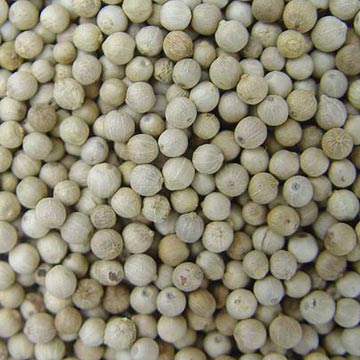 White pepper consists of the interior seed of the peppercorn, with the darker colored skin of the pepper fruit removed. A process known as retting is used, where fully ripe peppers are soaked in water for about a week, during which the flesh of the pepper softens and decomposes. Rubbing then removes what remains of the fruit, and the naked seed is dried. Alternative processes are used for removing the outer pepper from the seed, including decortication, the removal of the outer layer from black pepper from small peppers through mechanical, chemical or biological methods.
White pepper consists of the interior seed of the peppercorn, with the darker colored skin of the pepper fruit removed. A process known as retting is used, where fully ripe peppers are soaked in water for about a week, during which the flesh of the pepper softens and decomposes. Rubbing then removes what remains of the fruit, and the naked seed is dried. Alternative processes are used for removing the outer pepper from the seed, including decortication, the removal of the outer layer from black pepper from small peppers through mechanical, chemical or biological methods.
White pepper is sometimes used in dishes like light-colored sauces or mashed potatoes, where ground black pepper would visibly stand out. There is disagreement regarding which is generally spicier. They have differing flavor due to the presence of certain compounds in the outer fruit layer of the berry that are not found in the seed.

Green pepper
Green pepper, like black, is made from the unripe berries. Dried green peppercorns are treated in a way that retains the green color, and is then treated with sulfur dioxide or freeze-drying. Pickled peppercorns, also green, are unripe berries preserved in brine or vinegar. Fresh, unpreserved green pepper berries are used in some Asian cuisines, particularly Thai cuisine, but is relatively unused in the 'West.' Their flavor has been described as piquant and fresh, with a bright aroma, but they decay quickly if not dried or preserved.
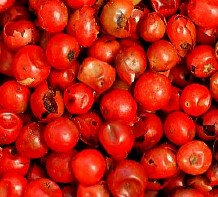
Orange pepper and Red pepper
Orange pepper or red pepper consists of ripe red pepper berries preserved in brine and vinegar. Ripe red peppercorns can also be dried using the same color-preserving techniques used to produce green pepper, mentioned above.

Pink pepper
Pink pepper from Piper nigrum is distinct from the more-common dried "pink peppercorns", which are the fruits of a plant from a different family, the Peruvian pepper tree, Schinus molle, and its relative the Brazilian pepper tree, Schinus terebinthifolius.
Sources
ezinearticles.com, wikipedia.org, www.plantcultures.org, www.whfoods.com, answers.encyclopedia.com , www.druera.com, www.jrmushroomsandspecialties.com, media-2.web.britannica.com,



